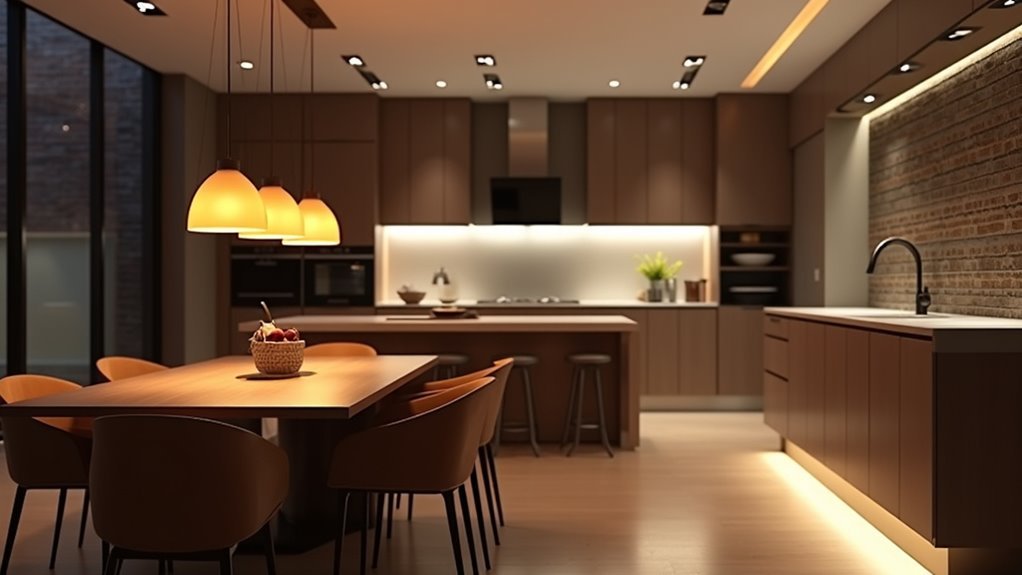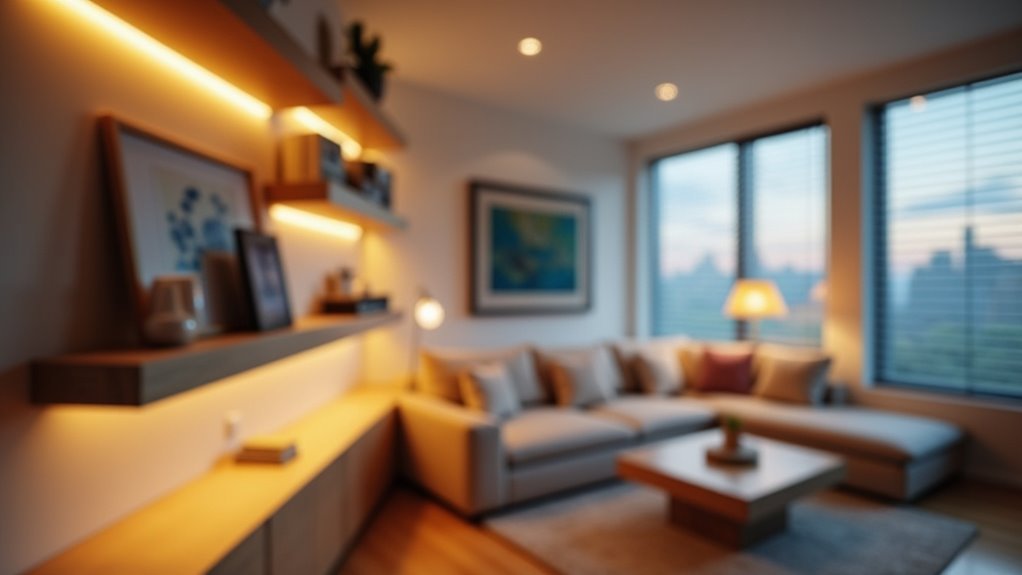You’re probably spending more on electricity than you need to, and your lighting system might be the biggest culprit. Smart lighting solutions can slash your energy bills by up to 75% while making your home more comfortable and convenient. From motion sensors that eliminate wasted power to adaptive controls that sync with your body’s natural rhythms, these five technologies will transform how you think about illumination and efficiency.
Motion Sensor Lighting Systems for Automated Control

Efficiency drives the evolution of modern lighting, and motion sensor systems represent a breakthrough in automated control energy management.
You’ll reduce energy consumption by 20% to 40% when you install motion sensors that automatically activate lights based on occupancy. These energy-efficient lighting solutions use PIR and HF sensors to detect movement, ensuring you’re only illuminating occupied spaces.
Smart lighting systems with motion sensors provide real-time monitoring capabilities, giving you insights into occupancy patterns while optimizing energy use.
In commercial settings, you’ll achieve substantial cost savings by preventing unnecessary lighting in unoccupied areas. The automated control features eliminate human error and forgetfulness, making your lighting expenses more predictable.
This technology delivers long-term financial benefits while supporting sustainable energy practices.
Daylight Harvesting Technology With Photo Sensors
How can you maximize natural light while minimizing energy waste? Daylight harvesting technology with photo sensors provides the perfect smart lighting solutions. These systems use photodetectors to monitor natural light levels, making real-time adjustments to artificial lighting based on changing conditions.
| Benefit | Impact |
|---|---|
| Energy Consumption Reduction | 20-40% savings on electricity costs |
| Integrated Smart Systems | Up to 60% overall energy reduction |
| Workplace Comfort | Enhanced productivity through ideal lighting |
| Environmental Impact | Minimize light pollution and support sustainability efforts |
| Automation Level | Intelligent lighting responds instantly to light changes |
You’ll reduce energy consumption considerably while supporting sustainability efforts. This intelligent lighting technology guarantees artificial lighting operates only when necessary, helping minimize light pollution. The automated system promotes workplace comfort and productivity while dramatically lowering your facility’s environmental footprint through efficient energy management.
Programmable LED Dimming and Scheduling Features

When you combine programmable LED dimming with intelligent scheduling features, you’ll gain unprecedented control over your lighting system’s energy consumption and performance.
You can adjust brightness levels precisely based on your specific needs, reducing energy consumption by up to 75% compared to traditional incandescent bulbs.
When you automate lighting through scheduling, you’ll achieve energy savings of 35% to 70% on overall lighting costs by ensuring lights operate only when needed.
Smart LED systems integrate seamlessly with motion sensors to automatically dim or turn off lights in unoccupied spaces.
You can align your artificial lighting with natural daylight availability, optimizing energy efficiency throughout your 4,200-hour annual operation cycle.
These intelligent lighting schedules enhance comfort while dramatically lowering your energy bills across various environments.
Smart Switches With Remote Energy Monitoring
Smart switches with remote energy monitoring transform your lighting control by providing real-time visibility into electricity consumption patterns throughout your home.
These control systems replace traditional switches and integrate with occupancy sensors to automatically turn lights off in unoccupied rooms, delivering energy savings of 20% to 40%.
You’ll reduce energy consumption through scheduling features that automate lighting based on time of day, ensuring lights operate only when needed.
Real-time tracking capabilities provide detailed energy reporting, showing which lights consume the most electricity.
This data helps you make informed decisions about optimizing your lighting setups.
Smart switches support lighting automation while integrating with other smart home systems for extensive energy management.
Over time, these devices contribute to significant reductions in your utility bills through improved efficiency.
Adaptive Lighting Controls for Circadian Rhythm Optimization

While traditional lighting systems provide static illumination, adaptive lighting controls dynamically adjust both brightness and color temperature throughout the day to mirror natural sunlight patterns.
These smart lighting solutions support your circadian rhythms, improving sleep quality and boosting cognitive performance by up to 20%.
You’ll achieve substantial energy savings through integrated daylight sensors that automatically reduce artificial light use by 20% to 40% during daylight hours.
Motion sensors further reduce energy consumption by ensuring lights activate only when spaces are occupied.
Dynamic lighting systems can cut your overall energy costs by 40% to 60%, delivering significant financial savings while supporting environmental sustainability.
This technology transforms your workspace into a healthier, more efficient environment that benefits both productivity and your bottom line.
Frequently Asked Questions
Does Smart Lighting Save Energy?
Yes, you’ll save significant energy with smart lighting. You can reduce consumption by 40-60% through motion sensors and daylight optimization. Smart bulbs use 70-90% less energy than incandescent bulbs, cutting your bills substantially.
What Are Energy-Efficient Lighting Solutions?
You’ll find LED bulbs are top energy-efficient solutions, using 70-90% less energy than incandescent bulbs. You can also install occupancy sensors and daylight harvesting systems to reduce consumption by 40%.
What Are Some Ways Lighting Systems Can Conserve Energy?
You can conserve energy by installing occupancy sensors that automatically turn lights off in empty rooms, using daylight harvesting systems that adjust brightness based on natural light, and programming automated schedules through smart controls.
How Can We Save Energy in Lighting?
You’ll save energy by switching to LED bulbs, installing motion sensors and timers, using dimmers, maximizing natural light, and choosing fixtures with automatic daylight adjustment features.





Leave a Reply